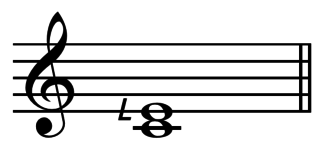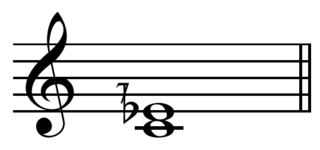

In music and tuning, the ragisma is an interval with the ratio of 4375:4374, [1] ≈0.396 cents (a superparticular ratio). It is usually defined as the difference between the septimal minor third (7:6) and two Bohlen–Pierce small semitones (27:25 ![]()
![]()


In music and tuning, the ragisma is an interval with the ratio of 4375:4374, [1] ≈0.396 cents (a superparticular ratio). It is usually defined as the difference between the septimal minor third (7:6) and two Bohlen–Pierce small semitones (27:25 ![]()
![]()

In classical music from Western culture, a diesis is either an accidental, or a very small musical interval, usually defined as the difference between an octave and three justly tuned major thirds, equal to 128:125 or about 41.06 cents. In 12-tone equal temperament three major thirds in a row equal an octave, but three justly-tuned major thirds fall quite a bit narrow of an octave, and the diesis describes the amount by which they are short. For instance, an octave (2:1) spans from C to C', and three justly tuned major thirds (5:4) span from C to B♯. The difference between C-C' (2:1) and C-B♯ (125:64) is the diesis (128:125). Notice that this coincides with the interval between B♯ and C', also called a diminished second.

The Bohlen–Pierce scale is a musical tuning and scale, first described in the 1970s, that offers an alternative to the octave-repeating scales typical in Western and other musics, specifically the equal tempered diatonic scale.

In classical music from Western culture, a third is a musical interval encompassing three staff positions, and the major third is a third spanning four semitones. Along with the minor third, the major third is one of two commonly occurring thirds. It is qualified as major because it is the larger of the two: the major third spans four semitones, the minor third three. For example, the interval from C to E is a major third, as the note E lies four semitones above C, and there are three staff positions from C to E. Diminished and augmented thirds span the same number of staff positions, but consist of a different number of semitones.

In music from Western culture, a sixth is a musical interval encompassing six note letter names or staff positions, and the major sixth is one of two commonly occurring sixths. It is qualified as major because it is the larger of the two. The major sixth spans nine semitones. Its smaller counterpart, the minor sixth, spans eight semitones. For example, the interval from C up to the nearest A is a major sixth. It is a sixth because it encompasses six note letter names and six staff positions. It is a major sixth, not a minor sixth, because the note A lies nine semitones above C. Diminished and augmented sixths span the same number of note letter names and staff positions, but consist of a different number of semitones.

A quarter tone is a pitch halfway between the usual notes of a chromatic scale or an interval about half as wide as a semitone, which itself is half a whole tone.

In music theory, a comma is a minute interval, the difference resulting from tuning one note two different ways. The word comma used without qualification refers to the syntonic comma, which can be defined, for instance, as the difference between an F♯ tuned using the D-based Pythagorean tuning system, and another F♯ tuned using the D-based quarter-comma meantone tuning system. Intervals separated by the ratio 81:80 are considered the same note because the 12-note Western chromatic scale does not distinguish Pythagorean intervals from 5-limit intervals in its notation. Other intervals are considered commas because of the enharmonic equivalences of a tuning system. For example, in 53TET, B
The semicomma, also Fokker's comma (after 31-TET pioneer Adriaan Fokker), is type of small musical interval, or comma, in microtonal music equivalent to 2109375:2097152, or 33×57 : 221. This is a ratio of approximately 1:1.0058283805847168, or about 10.06 cents (
In music, the septimal semicomma, a seven-limit semicomma, is the ratio 126/125 and is equal to approximately 13.79 cents. It is also called the small septimal comma and the starling comma after its use in starling temperament.

A septimal comma is a small musical interval in just intonation that contains the number seven in its prime factorization. There is more than one such interval, so the term septimal comma is ambiguous, but it most commonly refers to the interval 64/63.

In music, the septimal major third

In music, the septimal minor third
In music, a breedsma is an interval between pitches with the ratio of 2401:2400, which is the difference between the septimal diesis (49:48, also known as Slendro diesis) and the septimal sixth-tone (50:49, also known as jubilisma). It is about 0.72 cents (

In music, septimal diesis is an interval with the ratio of 49:48

A septimal quarter tone is an interval with the ratio of 36:35, which is the difference between the septimal minor third and the Just minor third, or about 48.77 cents wide. The name derives from the interval being the 7-limit approximation of a quarter tone. The septimal quarter tone can be viewed either as a musical interval in its own right, or as a comma; if it is tempered out in a given tuning system, the distinction between the two different types of minor thirds is lost. The septimal quarter tone may be derived from the harmonic series as the interval between the thirty-fifth and thirty-sixth harmonics.
In music, 41 equal temperament, abbreviated 41-TET, 41-EDO, or 41-ET, is the tempered scale derived by dividing the octave into 41 equally sized steps.

A septimal tritone is a tritone that involves the factor seven. There are two that are inverses. The lesser septimal tritone is the musical interval with ratio 7:5. The greater septimal tritone, is an interval with ratio 10:7. They are also known as the sub-fifth and super-fourth, or subminor fifth and supermajor fourth, respectively.
Septimal may refer to:

A septimal 1/3-tone is an interval with the ratio of 28:27, which is the difference between the perfect fourth and the supermajor third. It is about 62.96 cents wide. The septimal 1/3-tone can be viewed either as a musical interval in its own right, or as a comma; if it is tempered out in a given tuning system, the distinction between these two intervals is lost. The septimal 1/3-tone may be derived from the harmonic series as the interval between the twenty-seventh and twenty-eighth harmonics. It may be considered a diesis.

In music, a subminor interval is an interval that is noticeably wider than a diminished interval but noticeably narrower than a minor interval. It is found in between a minor and diminished interval, thus making it below, or subminor to, the minor interval. A supermajor interval is a musical interval that is noticeably wider than a major interval but noticeably narrower than an augmented interval. It is found in between a major and augmented interval, thus making it above, or supermajor to, the major interval. The inversion of a supermajor interval is a subminor interval, and there are four major and four minor intervals, allowing for eight supermajor and subminor intervals, each with variants.

In music theory, a neutral interval is an interval that is neither a major nor minor, but instead in between. For example, in equal temperament, a major third is 400 cents, a minor third is 300 cents, and a neutral third is 350 cents. A neutral interval inverts to a neutral interval. For example, the inverse of a neutral third is a neutral sixth.